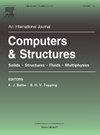Simulation of the TNT-based melt-cast explosive charging process using hot mandrel assisted solidification
IF 4.8
2区 工程技术
Q1 COMPUTER SCIENCE, INTERDISCIPLINARY APPLICATIONS
引用次数: 0
Abstract
The melt-cast charging process, widely used in warheads for its adaptability, cost efficiency, and automation, requires optimization to minimize defects such as shrinkage cavities and porosity that compromise explosive quality, destructive power, and safety, particularly in large-volume munitions. The hot mandrel technique, by providing localized heating during solidification, helps maintain an open feeding channel, thereby reducing defect formation and improving charge integrity. In this study, the solidification process of a TNT-based melt-cast explosive is investigated using ProCAST combined with an orthogonal test approach, focusing on the hot mandrel charging technique for a warhead. The influence of three primary process parameters—the hot mandrel length, heating time, and temperature—on the solidification process is analyzed. The results demonstrate that, compared to traditional natural solidification, the solidification process with hot mandrel assistance significantly reduces the occurrence of shrinkage cavities and porosity defects, decreases the volume of shrinkage-related flaws, and enhances the overall charge quality. Among the parameters studied, the heating time of the hot mandrel exerts the greatest influence on charge quality, followed by its temperature and length. Prolonging the heating time not only reduces shrinkage defects but also extends the solidification duration. Considering both defect reduction and solidification efficiency, the optimal process conditions within the tested range are as follows: a hot mandrel length of 350 mm, a heating time of 4000 s, and a hot mandrel temperature of 90 C. This study innovatively develops a numerical simulation approach using ProCAST for hot mandrel-assisted solidification, systematically investigating the effects of three critical parameters on charge quality. The proposed optimization framework balances defect control with production efficiency, providing theoretical guidance for industrial implementation.
基于tnt的熔铸炸药装药过程的热芯棒辅助凝固模拟
熔铸装药工艺因其适应性、成本效率和自动化而广泛应用于弹头,需要优化以最大限度地减少缺陷,如收缩腔和孔隙,这些缺陷会影响爆炸质量、破坏力和安全性,特别是在大容量弹药中。热芯棒技术,通过在凝固过程中提供局部加热,有助于保持一个开放的进料通道,从而减少缺陷的形成,提高电荷的完整性。采用ProCAST和正交试验相结合的方法,对tnt基熔铸炸药的凝固过程进行了研究,重点研究了战斗部的热芯棒装药技术。分析了热芯轴长度、加热时间和温度三个主要工艺参数对凝固过程的影响。结果表明,与传统的自然凝固相比,热芯棒辅助凝固工艺显著减少了缩孔和气孔缺陷的发生,减少了缩孔缺陷的体积,提高了整体装料质量。在研究的参数中,热芯棒的加热时间对电荷质量的影响最大,其次是温度和长度。延长加热时间不仅可以减少缩孔缺陷,而且可以延长凝固时间。考虑到缺陷减少和凝固效率,在测试范围内的最佳工艺条件为:热芯筒长度350 mm,加热时间4000 s,热芯筒温度90°C。本研究创新性地开发了一种使用ProCAST进行热芯棒辅助凝固的数值模拟方法,系统地研究了三个关键参数对电荷质量的影响。提出的优化框架平衡了缺陷控制与生产效率,为工业实施提供了理论指导。
本文章由计算机程序翻译,如有差异,请以英文原文为准。
求助全文
约1分钟内获得全文
求助全文
来源期刊

Computers & Structures
工程技术-工程:土木
CiteScore
8.80
自引率
6.40%
发文量
122
审稿时长
33 days
期刊介绍:
Computers & Structures publishes advances in the development and use of computational methods for the solution of problems in engineering and the sciences. The range of appropriate contributions is wide, and includes papers on establishing appropriate mathematical models and their numerical solution in all areas of mechanics. The journal also includes articles that present a substantial review of a field in the topics of the journal.
 求助内容:
求助内容: 应助结果提醒方式:
应助结果提醒方式:


